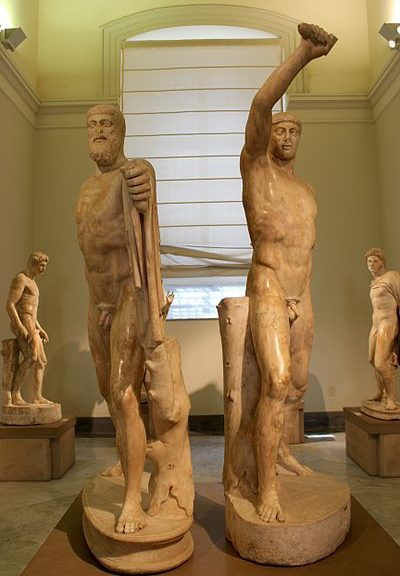Featured Artwork: Statue of Harmodius and Aristogeiton (Also known as Tyrannicide Monument)
 Original artists: Kritios and Nesiotes (477 BCE) in Athens, Greece.
Original artists: Kritios and Nesiotes (477 BCE) in Athens, Greece.
The only remaining pictured sculpture is a Greco-Roman copy that can be signified by the figure’s dependence upon faux wooden bases
Where can I view this artwork?: Naples National Archaeological Museum in Naples, Italy
Significance to Queer Art History:
The warrior lovers Harmodius (right) and Aristogeiton (left) rescued the ideals of democracy from a dictator and were heroes to Athens in 514 BCE. Thus, the statues of the warriors were commissioned to be displayed in the public forum. This was the 1st statue to honor mortal heroes instead of divine heroes in public.
Symbolism to note:
- Aristogeiton, the older warrior (left) lunges forward and offers a protective cloak for Harmodius. This may symbolize the warrior’s mutual devotion and platonic love to one another.
- Statues at this time were no longer static and archaic. Instead, they showed idealized realism and movement in posture as the figures place their feet forward and stand in contraposto (meaning, that weight is shifted to one side of the figure.)
- Both figures are nude. Nudity in Greek sculpture was reserved for gods/ goddesses, warriors, and athletes.
Resources & Further Reading:
“Crizio E Nesiote.” Crizio E Nesiote — Sito Ufficiale Del Museo Archeologico Nazionale Di Napoli. Accessed August, 2017. http://cir.campania.beniculturali.it/museoarcheologiconazionale/glossario/ploneglossarydefinition.2008-06-09.8429349527
“Perseus Digital Library.” Classical Tyrannicides (Sculpture). Accessed August, 2017. http://www.perseus.tufts.edu/hopper/artifact?name=Classical%2BTyrannicides&object=Sculpture.
Saslow, James M. Pictures and Passions: A History of Homosexuality in the Visual Arts. New York, NY: Viking, 2000. 17-21.




